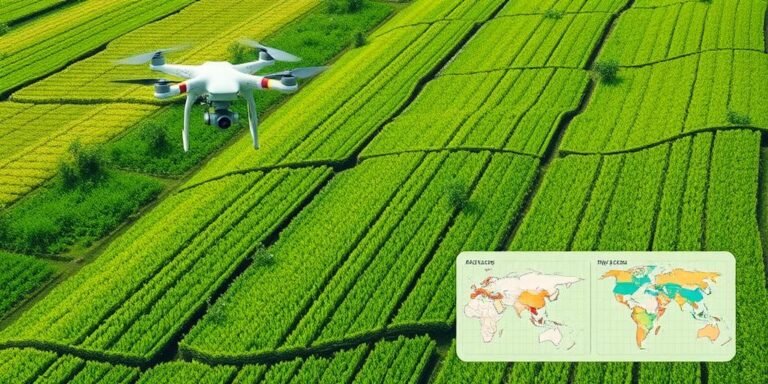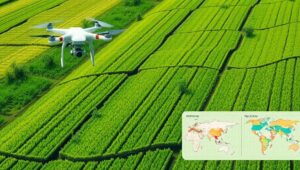AI in Agriculture: Precision Farming for a Hungry Planet (2025-2030)
As the global population surges, the challenge of feeding everyone sustainably intensifies. Agriculture, a sector steeped in tradition, is now poised for a technological revolution, with Artificial Intelligence (AI) at its core. This post explores how AI is transforming agriculture into a more precise, efficient, and sustainable practice, particularly focusing on the advancements expected between 2025 and 2030.
The Promise of Precision Farming
Precision farming, also known as smart farming, leverages data and technology to optimize agricultural processes. AI plays a crucial role in analyzing vast datasets collected from various sources, enabling farmers to make informed decisions about planting, irrigation, fertilization, and pest control. Here’s how AI is making a difference:
- Data-Driven Insights: AI algorithms analyze data from sensors, drones, satellites, and weather stations to provide real-time insights into crop health, soil conditions, and environmental factors.
- Automated Systems: AI-powered robots and automated systems can perform tasks such as planting, weeding, and harvesting with greater precision and efficiency than traditional methods.
- Predictive Analytics: AI models can predict crop yields, disease outbreaks, and market trends, helping farmers optimize their operations and minimize risks.
Key AI Applications in Agriculture (2025-2030)
-
Advanced Crop Monitoring:
- Drones and Satellite Imagery: High-resolution imagery combined with AI algorithms will enable farmers to monitor crop health at a granular level. Expect advancements in identifying nutrient deficiencies, disease symptoms, and pest infestations early on.
- AI-Powered Diagnostics: Imagine AI systems that can diagnose plant diseases in the field using smartphone cameras. This will become increasingly common, allowing for rapid response and targeted treatments.
-
Autonomous Farming Equipment:
- Self-Driving Tractors and Harvesters: Autonomous vehicles equipped with AI will navigate fields, plant seeds, and harvest crops with minimal human intervention. These machines will optimize routes, avoid obstacles, and work around the clock.
- Robotic Weeding and Pest Control: AI-powered robots will precisely identify and remove weeds or apply targeted treatments to individual plants, reducing the need for broad-spectrum herbicides and pesticides.
-
Precision Irrigation and Fertilization:
- Smart Irrigation Systems: AI algorithms will analyze soil moisture levels, weather forecasts, and plant water requirements to optimize irrigation schedules. This will conserve water and improve crop yields.
- Variable Rate Fertilization: AI-driven systems will apply fertilizers at variable rates based on the specific needs of different areas within a field. This will minimize nutrient runoff and maximize fertilizer efficiency.
-
Supply Chain Optimization:
- Demand Forecasting: AI models will predict consumer demand for agricultural products, enabling farmers and distributors to optimize their supply chains and reduce waste.
- Logistics and Transportation: AI-powered logistics systems will optimize transportation routes, reduce delivery times, and minimize spoilage, ensuring that fresh produce reaches consumers efficiently.
Challenges and Opportunities
While the potential of AI in agriculture is immense, several challenges must be addressed:
- Data Availability and Interoperability: Access to high-quality data is essential for training AI models. Efforts must be made to improve data collection, sharing, and standardization.
- Infrastructure and Connectivity: Reliable internet access and robust infrastructure are needed to support AI-powered agricultural technologies, particularly in rural areas.
- Skills and Training: Farmers and agricultural workers need to be trained in the use of AI technologies to fully realize their benefits.
- Ethical Considerations: Issues such as data privacy, algorithmic bias, and job displacement must be addressed to ensure that AI is used responsibly and equitably in agriculture.
Despite these challenges, the opportunities are vast. By embracing AI, agriculture can become more sustainable, efficient, and resilient, ensuring food security for a growing global population. The period between 2025 and 2030 promises to be a pivotal era for AI in agriculture, with innovations that will reshape the future of farming.
Conclusion
The integration of Artificial Intelligence into agriculture represents a significant leap towards a more sustainable and efficient food production system. As we move closer to 2030, the continued development and adoption of AI technologies will be crucial in addressing the challenges of feeding a growing planet while minimizing environmental impact. The future of farming is undoubtedly intertwined with AI, promising a new era of precision, productivity, and sustainability.




